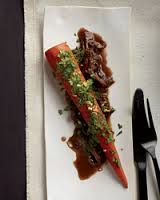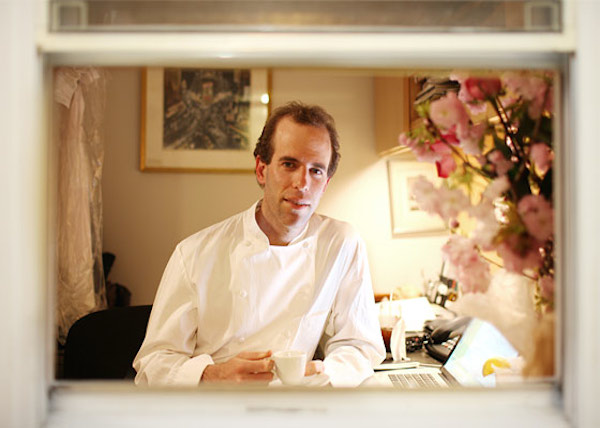Dan Barber has reached rock star status as a chef and culinary scholar. Now he’s revolutionizing how we think of sustainable eating (and living) in America.
Dan Barber’s accomplishments in the culinary world are outstanding if not unrivaled. The co-owner and executive chef of Blue Hill in Manhattan and Blue Hill at Stone Barns in Pocantico Hills, New York has been the recipient of several James Beard Awards including Best Chef in 2006 and the country’s Outstanding Chef in 2009. He was chosen by President Obama to be part of the Council on Physical Fitness, Sports and Nutrition, he has been a regular contributor to the op-ed section of the New York Times, and he was even named one of Time Magazine’s 100 most influential people in the world in 2009.
Despite all of these accolades, what Barber is becoming most known for is being one of the leading advocates for sustainable farming and revolutionary eating practices in the United States. He is truly on a crusade to teach Americans how to appreciate their land and improve their diets.
 Barber’s entire culinary philosophy is based on a farm to table system. Both of his Blue Hill restaurants are supplied by two farms: one on the grounds of the Stone Barns Center for Food and Agriculture, where Barber served on the board before opening the restaurant there, and the other by the Blue Hill Farm owned by his family in Great Barrington, Massachusetts.
Barber’s entire culinary philosophy is based on a farm to table system. Both of his Blue Hill restaurants are supplied by two farms: one on the grounds of the Stone Barns Center for Food and Agriculture, where Barber served on the board before opening the restaurant there, and the other by the Blue Hill Farm owned by his family in Great Barrington, Massachusetts.
Barber has traveled and explored viable food options in other countries. He has presented TED talks on a Spanish goose farmer who produces what Barber says is the best foie gras in the world simply by catering to the wants of his geese in a completely humane (without force-feeding or caging) way, and on a Spanish biologist who has devised a way to maintain a self-renewing fish farm that almost perfectly emulates a natural environment.
“We must face our future and realize the way we grow and eat food is unsustainable,” Barber said on the topic of American agriculture in a recent interview with mindful Magazine.
The chef, trained at the French Culinary Institute, who also boasts an English degree from Tufts University, explains that our modern goals of eating local and free range foods are steps in the right direction but require a complete paradigm shift to make a true difference.
In other words, we cannot simply eat grass fed beef and locally grown vegetables and expect to create a sustainable agricultural environment. Instead, we must begin to understand what our landscape needs and cater to that by changing what we put on our plates and what we plant in our soil.
Barber’s book, The Third Plate explains his philosophy as well as the history of what we eat in America and what is eaten in cultures across the globe.
The text lays out three stages of American cuisine. The first plate he describes is the past, or traditional plate, constructed of a large portion of meat, a small side of vegetables and perhaps a grain. This model, which has been so typical on American tables, comes from generations of improper farming practices that catered more to popular demand than care for the land.
The second plate factors in current trends of eating local and free-range foods in the hope of promoting sustainability, a trend commonly referred to as locavorism. Barber points out that the chemical free cattle raising and local farming theories are sound but that they mean little without adopting a diet that complements them.
In a 2012 interview with the Wall Street Journal, Barber said, “True sustainability is about more than just deciding to cook with local ingredients or not allowing your child to have corn syrup. It’s about cuisine that’s evolved out of what the land is telling you it wants to grow.”
Much like the Spanish geese, who when catered to and allowed to flourish naturally, produce the tastiest foie gras in the world, Barber says that mindful farming will produce the tastiest produce.
In other countries such as China and France, sustainable cuisine has come from necessity. Peasant farmers have learned what the optimal crop rotations are to get and sustain the most fertility from their soil. They have also learned to use every part of the animals that they consume and have gotten their protein from secondary cuts of meat and fish that would be considered scrap in America.
America does not have a tradition of peasant farming. Instead it has a tradition of following trends, i.e. the industrial revolution and all of the fad farming of today (Barber cites quinoa and kale, which are healthy but not necessarily good for every soil region of our country).
 Barber’s third plate is an example of the type of meal that would coincide with a landscape-friendly American agricultural environment. The largest portion would be a carrot steak. That’s right folks, a carrot steak! (Before you omnivores stop reading, he is not advocating a strictly vegetarian diet, quite the opposite in fact, and Barber’s egg-coated, fried recipe is much more appetizing than “carrot steak” sounds).
Barber’s third plate is an example of the type of meal that would coincide with a landscape-friendly American agricultural environment. The largest portion would be a carrot steak. That’s right folks, a carrot steak! (Before you omnivores stop reading, he is not advocating a strictly vegetarian diet, quite the opposite in fact, and Barber’s egg-coated, fried recipe is much more appetizing than “carrot steak” sounds).
The rest of the plate is filled out with leafy greens (locally grown of course) and protein in the form of braised second cuts of beef in a savory sauce.
Specific crops that Barber suggests for American soil include cat tails and wild perennial strains of wheat, although he stresses that attention must be paid to regional differences. Pennsylvania’s agriculture must and will differ from Oklahoma’s.
The chef and food activist also preaches the importance of not separating animals, vegetables and grains. In an ideal nutrient cycle, grains feed animals who fertilize the soil where vegetables grow, and they all feed us (hopefully continually as this system can be sustained).
As fossil fuels, predictable weather patterns and abundant water supplies dwindle, the American food industry must change and look toward the age old relationship of the peasant farmer to the land he or she is working.
Barber points out that agriculture is not a natural practice. It manipulates plants and land, but he believes there is a right way to farm. His theory is that we can work the land in a way that is considerate and well planned enough to yield the best results in the form of the best produce and the most flavorful pieces of meat.
In his interview with mindful Magazine he said, “The best-tasting food, the food we’re drawn to, comes from a system of agriculture that respects the natural. It’s about realizing that in all parts of the world the best-tasting ingredients come from systems orchestrated by the farmer and the community he or she is respecting.”
[images: via nymag, Food52 and google images]











